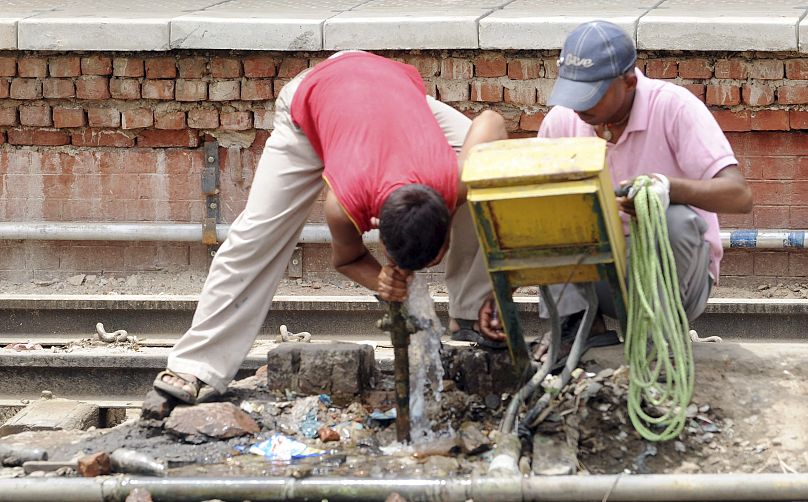An expert explains what another 1C of warming could mean for people who work outdoors around the world.
At least five people in Italy have died while working in July’s brutal heatwave, prompting calls for furloughs during extreme heat.
Stefano Olmastroni’s body was 43C when he was found slumped inside the changing rooms of a Florence supermarket. The 61-year-old cleaner had told relatives he was struggling in the aircon-less greenhouse area, but finished his shift, looking forward to a free day tomorrow.
A 44-year-old road worker in Milan, two construction site labourers in Jesi and Brescia and a baker from Veneto also lost their lives in gruelling conditions this month, as two anticyclones struck southern Europe.
The real death toll is likely much higher. Last summer's heatwave killed more than 61,000 people across Europe, a recent study shows. As climate change dials up the intensity of heatwaves, countries are having to consider new protections for workers.
Spain is banning some outdoor work during periods of extreme heat, following the death of a street cleaner from heat stroke in Madrid last year. For the first time ever this month, Greece has also placed a ban on people working in the construction and delivery sectors during the hottest hours of the day.
Now the FenealUil trade union in Italy is calling for paid leave for staff when temperatures exceed 35C.
With Europe facing more and more days of ‘extreme heat stress’ in a warming world, such workplace protections are vital, says climate scientist Luke Parsons.
We spoke to Parsons - who studies the impact of climate on human health, particularly on outdoor workers - about this growing issue and its possible solutions.
Where are workers most at risk from heat?
“People always ask me… what does one degree of warming matter?” says Parsons, who is based at Duke University in North Carolina.
“We’re at the threshold for places, especially in southern Europe in the summertime and the southeastern US, where a lot of hours of the day are near the safety threshold for work,” he explains.
“And with just one degree of warming, it punts you over that threshold.”
Globally speaking, Europe is not on the deadliest frontlines of heat.
The places where Parsons worries most about workers are tropical South America, Sub-Saharan Africa, southwest Asia - Pakistan and northern India especially - Bangladesh, Cambodia, southeast Asia, eastern China, stretching into Indonesia and northern Australia.
“These are places where the hottest parts of the day are so hot that people shouldn’t be doing work at all if it’s heavy labour,” he says.
On a map of the world showing where temperatures most often peak above 26.5C wet-bulb globe temperature (WBGT), these regions are cloaked in red, purple and black tones. Some areas already experience 50 per cent of all hours on average at this critical WGBT - the gold standard for heat which incorporates humidity, wind speed and radiation as well as air temperature.
The ISO gives 26.5C as the level above which people need to take breaks and drink plenty of water; all heavy work should stop over 32-33C, it states.
In most of Europe, on average only around 5 per cent of hours in the last 20 years have been above 26.5C. Andalusia, southern and eastern Spain, Italy and parts of the eastern Mediterranean stick out for having more frequent hot days.
But adding one degree of heat sees the stain of unworkable heat darkening and spreading further into central Europe.
In northern Europe, the historic infrequency of heatwaves presents its own kind of risks.
“It can be really dangerous for places like northern Europe and the northern US to experience a heatwave. Because people might not be acclimatised to the heat,” says Parsons.
What is the impact of extreme heat on outdoor workers?
Sweat is the key way that the human body cools itself down. It can be inhibited by humidity - which prevents sweat from evaporating off the skin - and clothing. People spraying pesticides in fields, for example, may wear less breathable clothing to protect themselves from chemicals, but end up encased in sweat.
Internal characteristics of the body - health, age and medication - also alter workers’ ability to withstand extreme heat, explains Parsons, as well as the intensity of the work.
There’s a growing awareness of the impact of heat on labourers - tragically intensified by the deaths of workers from Italy to India.
“The thing with heat that worries me, though, is that it’s not like a traumatic, violent death or means of injury,” says Parsons. “People will often call it one of the silent killers because people can die at home alone because of heat exposure.”
“You have people who are getting severe kidney injuries on job sites,” he adds, “because they’re dehydrating and working in the heat.”
Chronic kidney disease of unknown origin (CKDu) was first diagnosed in the 1990s among agricultural communities in hot, humid regions of Central America. Studies suggest that the global spread of CKDu in recent years could be due to escalating temperatures at work.
Although there’s increased awareness of the issue, Parsons believes “we have a long way to go in terms of encouraging protections for vulnerable workers who might be paid, let’s say, by every kilo they can harvest.”
“So they push themselves right through, even if it’s too hot.”
Is shifting working hours to cooler times of the day a good idea?
In a 2021 study, Parsons and colleagues investigated the potential of shifting work to cooler times of the day.
Many workers around the world already do this, of course; pausing during the peak heat of the afternoons to take breaks in the shade.
“People do that if you give them a chance, usually, and it’s good to have local regulations that encourage it,” says Parsons. Regulations, he adds, should also ensure access to cool clean water.
Shifting work hours can be an effective local strategy but, as climate change starts to heat up even the typically cooler early hours of the morning, it’s a limited solution.
There are other barriers to moving work hours too, explains Parsons. Like noise regulations prohibiting construction work at 3 am; a lack of childcare and other familial, health and safety problems if peoples’ sleep cycles are disrupted.
What are the solutions for overheated workers?
Acclimatisation is one of the most important positive influences, says Parsons. Enabling workers to ease into a hot and humid environment over a couple of weeks can protect people from the equivalent of around 2.5C warming of WGBT.
In wealthier European countries, there’s been a shift towards using more machinery - mechanising a lot of heavy, outdoor labour. Of course, this brings its own threats to job security.
With any policy, there’s going to be unintended consequences, Parsons acknowledges. On the whole, the Spanish ban sounds like a good idea to the heat and labour expert.
“If we don’t encourage workplace protections that are mandated, often workers don’t have the knowledge to protect themselves or the managers of the job sites don’t know how to protect them,” he says.
“If you at least mandate that people need to slow or stop work, if it hits certain heat thresholds, then you’re at least starting to create a culture around protecting people and prioritising their health and wellbeing over just continuous work.”
Trade unions are picking this issue up at different policy levels, explains Bert De Wel, global climate policy coordinator at the International Trade Union Confederation (ITUC).
At the company and sector level, the ITUC is proposing that heat stress be integrated in collective bargaining agreements.
Nationally, it is supporting trade unions to have climate impacts integrated in national social protection systems, he adds; for example, ensuring unemployment benefits cover loss of working hours due to heat stress and floods.
And at the International Labour Conference last month, the confederation called on the ILO to produce global guidelines on extreme weather events, temperature stress and changing climate patterns.



















